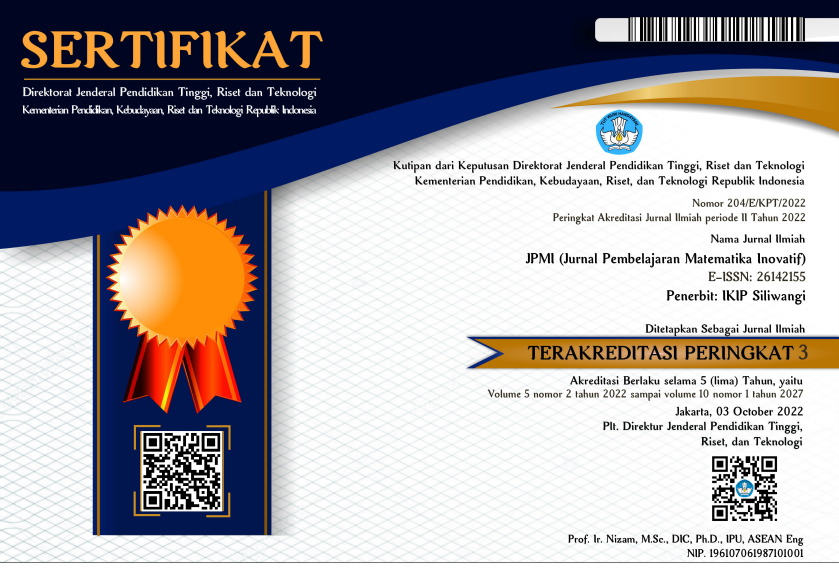Peningkatan kemampuan representasi matematis siswa melalui model pembelajaran berbasis inkuiri berbantuan software geogebra
DOI:
https://doi.org/10.22460/jpmi.v7i5.26063Keywords:
Representation Ability, Inquiry Learning, Geogebra SoftwareAbstract
The students' inadequate mathematical representation abilities, as seen by their trigonometry learning outcomes, are the driving force for this investigation. This study aims to determine whether using Geogebra software in combination with an inquiry-based learning approach may improve students' mathematical representation skills. Of the seventy students enrolled at SMA Negeri 1 Ketambe, twenty-five students from class X IPA 1 and twenty-five students from class X IPA 2 were assigned to the experimental and control courses, respectively. The second class used a quasi-experimental technique with a pre- and post-test design. Tests used as research instruments. The data analysis methods that were employed were the N-Gain Test, Normality Test, Homogeneity Test, and T-Test. The results of the study on hypothesis testing indicate that an inquiry-based learning model can enhance students' capacity for mathematical representation, and that students who employed this strategy saw higher gains in this capacity than those who received conventional instruction.
References
Anggraini, L., & Sari, R. (2021). Pengaruh Model Pembelajaran Inkuiri Terbimbing Terhadap Kemampuan Representasi Matematis Siswa SMP. Jurnal Pendidikan Matematika, 12, 183–192.
Arikunto. (2019). Prosedur Penelitian : Suatu Pendekatan Praktik. Rineka Cipta.
Artigue,M.,& Hanna, G. (2019). Representasi Matematis Dalam Pendidikan Matematika. Springer.
Asriani, R., Hakim, A., & Efwinda, S. (2021). Efektivitas Model Pembelajaran Inkuiri Terbimbing untuk Meningkatkan Kemampuan Berpikir Kreatif Siswa SMA pada Materi Momentum dan Impuls. Jurnal Literasi Pendidikan Fisika (JLPF), 2(1), 34–43. https://doi.org/10.30872/jlpf.v2i1.397
Drijvers, P., &Van Eerde, D. (2019). The Role Of Digital Resources In Supporting Representational Fluency. Springer.
Dwirahayu, G., Sandri, M., & Kusniawati, D. (2020), Inquiry Based RME Terhadap Kemampuan Representasi Matematis Siswa. FIBONACCI: Jurnal Pendidikan Matematika Dan Matematika, 6(1), 45-58. https://doi.org/10.24853/fbc.6.1.45-58
Ekawati, M. (2019). Teori Belajar Menurut Aliran Psikologi Kognitif Serta Implementasinya Dalam Proses Belajar Dan Pembelajaran. Seminar Nasional: Jambore Konseling 3, 07(00), XX–XX. https://doi.org/10.1007/XXXXXX-XX-0000-00
Hake, R. R. (1999). Analyzing Change/Gain Scores. American Educational Research Association’s Division Measurement and Research Methodology, 1–4
Hohenwarter, M., & Jones, K. (2019). The Routledge Handbook Of Mathematical Representation. Routledge.
Hoque, M. R., Kabir, M. H., & Yang, S.-H. (2017). Development of a Cooperative Middleware to Provide Context-Aware Service in Smart Home. International Journal of Smart Home, 11(5), 33–40. https://doi.org/10.14257/ijsh.2017.11.5.03
Kline, M. (2017). Mathematics: The Loss Of Certainty. Oxford University Press.
Kusmaryono, I., & Dwijanto, D. (2016). Peranan Representasi Dan Disposisi Matematis Siswa Terhadap Peningkatan Mathematical Power. JIPMat, 1(1), 19–28. https://doi.org/10.26877/jipmat.v1i1.1089
NCTM. (2014). Principles To Actions : Ensuring Mathematical Success For All. VA: NCTM.
Purwanto, P. (2019). Pengaruh Penggunaan Software Geogebra Terhadap Kemampuan Representasi Matematis Siswa SMP Pada Materi Geometri. Jurnal Pendidikan Matematika Dan Sains, 4(1), 1–10.
Rachmantika, A. R., & Wardono. (2019). Peran Kemampuan Berpikir Kritis Siswa Pada Pembelajaran Matematika Dengan Pemecahan Masalah. Prosiding Seminar Nasional Matematika, 2(1), 441.
Rahmadian, N. M. (2019). Kemampuan Representasi Matematis Siswa dalam Model Pembelajaran Somatic, Auditory, Visualization, Intellectually. PRISMA. Prosiding Seminar Nasional Matematika, 2, 287–292. https://journal.unnes.ac.id/sju/index.php/prisma/
Ramziah, S. (2016). Peningkatan Kemampuan Representasi Matematis Siswa Kelas X 2 SMAN 1 Gedung Meneng Menggunakan Bahan Ajar Matriks Berbasis Pendekatan Saintifik. 5(2007).
Rukminingsih, G. A. D. M. A. L. (2020). Metode Penelitian Pendidikan (1st ed.). Erhaka Utama. https://www.researchgate.net/profile/Rukminingsih_Rukminingsih/publication/343179796_METODE_PENELITIAN_PENDIDIKAN_Kuantitatif_Kualitatif_Penelitian_Tindakan_Kelas/links/5f1a7338a6fdcc9626ad33e6/METODE-PENELITIAN-PENDIDIKAN-Kuantitatif-Kualitatif-Penelitia
Sadana, D. A., & Jayanti, P. P. (2020). Penyelesaian Soal Cerita pada siswa Diskalkulia ditinjau dari Teori Bruner dengan Metode Drill. Jurnal Pendidikan Matematika, 14.
Sara, R. W., Gunowibowo, P., & Asnawati, R. (2017). Efektifitas Model Pembelajaran Inkuiri Terbimbing Ditinjau Dari Kemampuan Representasi Matematis Siswa. Jurnal Pendidikan Matematika Unila, 5, 1028–1039.
Soedjadi. (2014). Pengantar Matematika. Grasindo.
Sowder, J. . (2015). Mathematics Education As A Discipline. Routledge.
Sugiyono. (2023). Metode Penelitian Kuantitatif, Kualitatif, dan R&D. Alfabeta.
Sugrah, Nurfatimah. (2019). Implementasi Teori Belajar Konsttruktivisme Dalam Pembelajaran Sains. Humanika, Kajian Ilmiah Mata Kuliah Umum, 19(2),121-138. https://journal.uny.ac.id/index.php/humanika/article/download/29274/pdf
Utami, P. R., Junaedi, I., & Hidayah, I. (2018). Mathematical representation ability of sudeents’ grade X in mathematics learning on problem based learning. Unnes Journal of Mathematics Education, 7(3), 164–171. https://doi.org/10.15294/ujme.v7i1.25486
Downloads
Published
Issue
Section
License

This work is licensed under a Creative Commons Attribution-ShareAlike 4.0 International License.
The author is responsible for acquiring the permission(s) to reproduce any copyrighted figures, tables, data, or text that are being used in the submitted paper. Authors should note that text quotations of more than 250 words from a published or copyrighted work will require grant of permission from the original publisher to reprint. The written permission letter(s) must be submitted together with the manuscript.
















